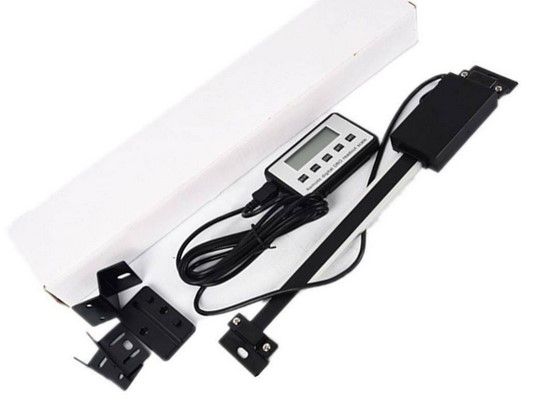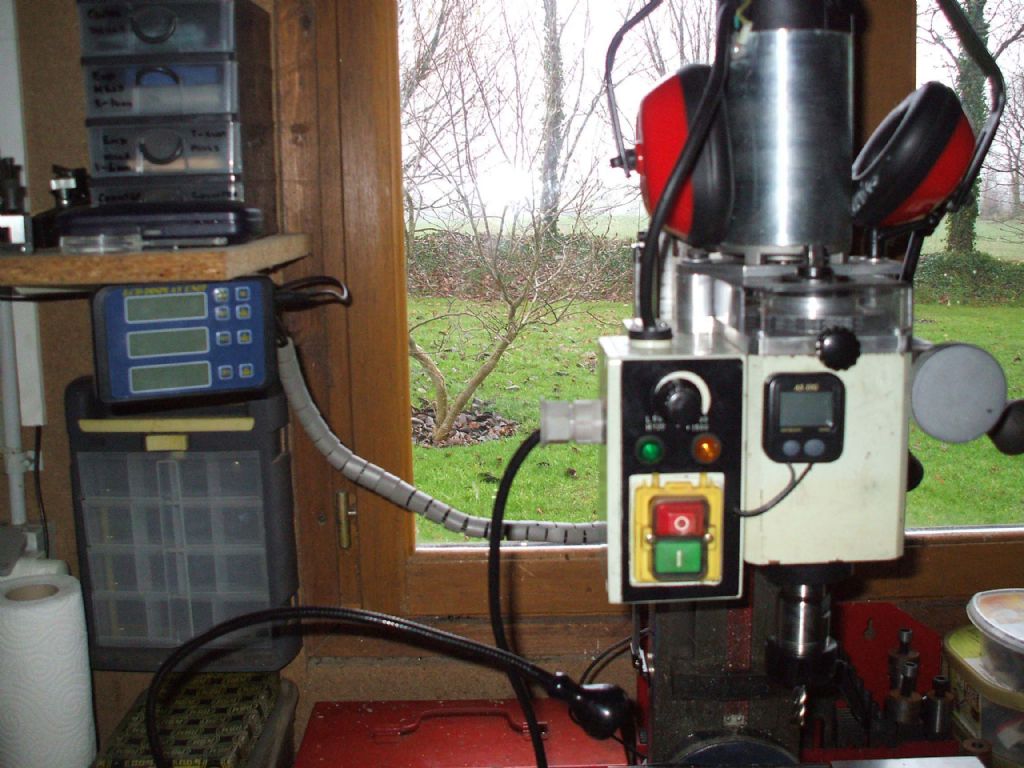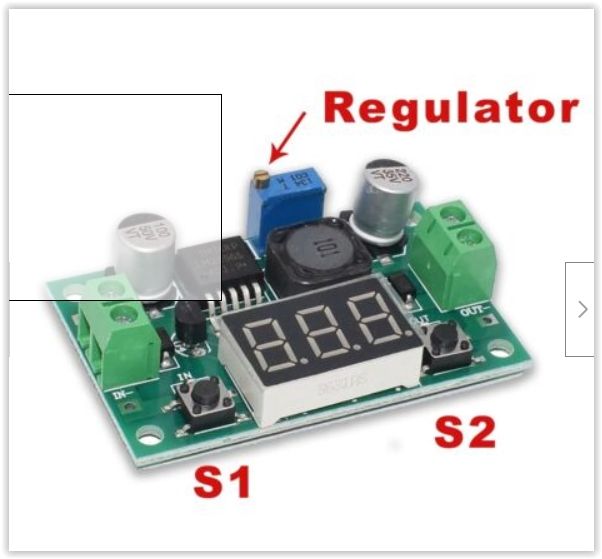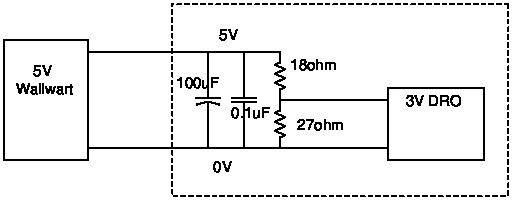Dro, mains power adaptor.
| John MC | 14/04/2023 11:03:17 |
464 forum posts 72 photos | I use several of these types of DRO in my workshop. Powered by a either one or two 3volt button cells (CR2032). These batteries never seem to last long so was wondering if anyone has made them work from a suitable 240 volt to 3 volt mains adaptor. Anyone got any ideas for doing this? John
|
| Michael Gilligan | 14/04/2023 11:58:17 |
23121 forum posts 1360 photos | A Google search for cr2032 dummy returns a number of interesting avenues to explore. MichaelG. |
| John Haine | 14/04/2023 13:39:26 |
| 5563 forum posts 322 photos | The ones that need 2 cells, are they in series or parallel? |
| Fulmen | 14/04/2023 13:49:06 |
120 forum posts 11 photos | I suspect they would handle 5V just fine, making USB power a viable option. 3D printing a replacement battery lid shouldn't be too hard. |
| John Haine | 14/04/2023 14:01:53 |
| 5563 forum posts 322 photos | Modern 3v logic families tend to smoke if supplied with 5v... |
| John Hinkley | 14/04/2023 14:28:56 |
1545 forum posts 484 photos | John MC, It is a good few years since I fitted my mini mill with 3-axis scales, obtained from ArcEuroTrade. Like you I found that the batteries didn't last long and I quickly replaced the supplied individual read out displays with a mains powered one similar to, if not identical to the one in the link above. I cannot say whether the voltage supplied to the read head is3V, 5V or 6V. The fact that it is supplied via a usb cable would suggest, to me, that it's 5V. An email to ARC would undoubtedly elicit a definitive answer. Not a cheap solution, but the saving in battery costs should be recouped within 8 to 10 years or so. Not a brilliant photo, but it worked well enough within the limitations of the mill (and its operator). When we moved back to the UK in 2015, I sold the mill and scales etc to a friend nearby, to be replaced with a Warco VMC with glass scales soon after arrival in England. Another alternative, I suppose is a Touchdro system from YurisToys of which I have read but have no experience I believe others on the forum have used this system however and if you happen to have an unused Android tablet lying around the place, could be a cost-effective solution. John
|
| SillyOldDuffer | 14/04/2023 15:04:09 |
| 10668 forum posts 2415 photos | Posted by John Haine on 14/04/2023 13:39:26:
The ones that need 2 cells, are they in series or parallel? I believe parallel, so 5V is over the top. A while ago I experimented with a PSU powered digital caliper and found the electronics very vulnerable to electrical noise picked up by the power cable. The caliper had no decoupling, because it's not needed with a battery on very short leads Replacing the battery with a cabled PSU is complicated by the need to keep the power clean. A bit tricky because the caliper and John's DRO are both sensitive high-impedance devices. I've toyed with the idea of simply connecting a bigger battery. If my caliper was typical, the reason CR2032 cells don't last long is because the circuit has a high voltage threshold and stops working long before the cell is fully discharged. Dave |
| duncan webster | 14/04/2023 16:24:49 |
| 5307 forum posts 83 photos | When the spring better connector on my digital depth gauge broke I just soldered 2 short tails on and then attached an external AAA battery. Crude but effective. |
| Stuart Smith 5 | 14/04/2023 16:57:39 |
| 349 forum posts 61 photos | John MC I have 3 of these fitted to my mill and found the display a bit small, so I made an interface box to use the scales with the TouchDRO app on a cheap android tablet. It uses an Arduino nano and a Bluetooth module.
This then provides power to the scales using the 3v output from the Arduino. Even though the connectors on the scales are micro usb types they are not 5v.
This is picture of the TouchDRO app. This one is on my mini lathe. Stuart Edited By Stuart Smith 5 on 14/04/2023 16:58:49 Edited By Stuart Smith 5 on 14/04/2023 17:02:06 |
| John Doe 2 | 14/04/2023 19:06:02 |
441 forum posts 29 photos | Slightly off topic, well parallel I suppose: I got fed up with the short-lived button cells in my digital callipers, so I bought a mechanical dial calliper from Dasqua. Now, my callipers always "switch on" and the battery is never flat, (there is no battery !). The mark one eyeball and 2 decimal places is more than enough for me - no precision metalwork involved. The on/off switch of electronic devices uses battery power to sense the pushbutton switch, so it is always supplying current. It probably only draws nano amps for this, but that seems to be enough to shorten the battery life considerably. I am surprised that nobody manufactures such things with a rechargeable battery and a mini USB connector. Edited By John Doe 2 on 14/04/2023 19:07:43 |
| Zan | 14/04/2023 19:54:27 |
| 356 forum posts 25 photos | 1 get a battery box for rechargeable big celks at a much higher voltage than required I saw one at 3-35 v input 2 get a £3 variable voltage regulator from ebay set voltage to same as cells 3 fabricate dummy cell replacements to fit in the scale 4 fit in a case with an on off switch
job done |
| old mart | 14/04/2023 20:49:10 |
| 4655 forum posts 304 photos | Some of these DRO's have a connection for an external power source, check and have a look at the instructions if there are any. |
| Paul Lousick | 15/04/2023 07:12:26 |
| 2276 forum posts 801 photos | If your DRO only has a 3 volt supply, use a voltage converter (buck converter) to reduce the voltage. Like this one that sells on ebay for £4.20 . Power supply can be any old DC phone/computer adaptor. |
| John MC | 15/04/2023 15:48:42 |
464 forum posts 72 photos | Many thanks for the replies. I was hoping that I could use a 3 volt power supply, the sort that looks like a fat 13 amp plug. As has been suggested, the electrical output is noisy, the device won't like it. Also, my understanding of these PSU's is that they need to be made to "work". That is to say, the very low power demand of the DRO may not be controlled very well by the PSU. I wonder if using one of these powering a voltage controller may still have problems with electrical noise? At the moment I am favouring a larger battery to power the DRO. I'll need to make a dummy battery with flying leads. My last thought would be to use a mains USB adaptor connected to a voltage control device, (as in the previous post). Would this be electrically clean enough?
|
| Michael Gilligan | 15/04/2023 18:22:57 |
23121 forum posts 1360 photos | John, Those buck converters are excellent for dimming LEDs and such, but they work by Pulse Width Modulation, so there is certainly some risk of introducing noise. You may, or may not, have problems MichaelG. . Ref. __ an extremely detailed data-sheet from TI here: https://www.ti.com/lit/ds/symlink/lm2596.pdf Edited By Michael Gilligan on 15/04/2023 18:29:56 |
| SillyOldDuffer | 16/04/2023 09:15:49 |
| 10668 forum posts 2415 photos | Posted by John MC on 15/04/2023 15:48:42:...
My last thought would be to use a mains USB adaptor connected to a voltage control device, (as in the previous post). Would this be electrically clean enough?
Probably, except for the electrical noise picked up between the wall-wart and the DRO. The DRO expects a few clean DC microamps but what it gets is DC with a strong whiff of mains-hum, high frequency switch-mode spikes, and transients from motor brushes, VFDs, and other electrical clatter. Microamp level noise on the line is usually harmless because it's tiny compared with the hundreds of milliamps normally delivered into the load by the wall-wart, plus the load is decoupled to remove it. A DRO of this type is unlikely to have any decoupling because there's no long power lead acting as an antenna, and batteries don't add electrical noise. I suggest a circuit that replaces the missing decoupling and reduces the relative level of unwanted noise by loading the wall-wart more heavily. Should also improve it's regulation.
All the components inside the dashed box must be as close to the DRO terminals as possible. The wall-wart cable can be as long as is needed. Works thus:
Comment: 100uF and 0.1uF are typical values. I'd expect them to work, but de-noising can be a fiddly job. The optimum depends on whatever noise is actually present, so it may be necessary to experiment, or do the maths necessary to design a proper filter. Keeping it simple, if the DRO misbehaves, start by adding a 0.01uF capacitor directly across the battery terminals. If that doesn't tame the beast, try various substitutes for the 0.1uF between, say, 0.47uF and 0.047uF. Easier to do with an oscilloscope, but not every workshop has one! Dave
Edited By SillyOldDuffer on 16/04/2023 09:16:38 |
| john fletcher 1 | 16/04/2023 10:20:25 |
| 893 forum posts | Morning all, I notice DAVE above, suggest using a oscilloscope to locate electrical noise. I recently advertised a Farnell oscilloscope for sale in MEW magazine. John |
| not done it yet | 16/04/2023 10:53:03 |
| 7517 forum posts 20 photos | I am fairly confident that my 3 axis DRO readout can run from the mains, without any CR2032 cells in the readers. It is powered by a 6 volt 1 amp switched mode power supply, I believe. I believe that it is likely that you do not switch off the each reader when not in use? I expect that if you did, the cells would, in fact, last quite a lot longer. Likely a function of when it is off (really off) and not off (on stand-by🙂 ). This is mine: DIGITAL DISPLAY UNITS Edited By not done it yet on 16/04/2023 10:53:52 |
Please login to post a reply.
Want the latest issue of Model Engineer or Model Engineers' Workshop? Use our magazine locator links to find your nearest stockist!
Sign up to our newsletter and get a free digital issue.
You can unsubscribe at anytime. View our privacy policy at www.mortons.co.uk/privacy
- hemingway ball turner
04/07/2025 14:40:26 - *Oct 2023: FORUM MIGRATION TIMELINE*
05/10/2023 07:57:11 - Making ER11 collet chuck
05/10/2023 07:56:24 - What did you do today? 2023
05/10/2023 07:25:01 - Orrery
05/10/2023 06:00:41 - Wera hand-tools
05/10/2023 05:47:07 - New member
05/10/2023 04:40:11 - Problems with external pot on at1 vfd
05/10/2023 00:06:32 - Drain plug
04/10/2023 23:36:17 - digi phase converter for 10 machines.....
04/10/2023 23:13:48 - More Latest Posts...
- View All Topics
- Reeves** - Rebuilt Royal Scot by Martin Evans
by John Broughton
£300.00 - BRITANNIA 5" GAUGE James Perrier
by Jon Seabright 1
£2,500.00 - Drill Grinder - for restoration
by Nigel Graham 2
£0.00 - WARCO WM18 MILLING MACHINE
by Alex Chudley
£1,200.00 - MYFORD SUPER 7 LATHE
by Alex Chudley
£2,000.00 - More "For Sale" Ads...
- D1-3 backplate
by Michael Horley
Price Not Specified - fixed steady for a Colchester bantam mark1 800
by George Jervis
Price Not Specified - lbsc pansy
by JACK SIDEBOTHAM
Price Not Specified - Pratt Burnerd multifit chuck key.
by Tim Riome
Price Not Specified - BANDSAW BLADE WELDER
by HUGH
Price Not Specified - More "Wanted" Ads...
Do you want to contact the Model Engineer and Model Engineers' Workshop team?
You can contact us by phone, mail or email about the magazines including becoming a contributor, submitting reader's letters or making queries about articles. You can also get in touch about this website, advertising or other general issues.
Click THIS LINK for full contact details.
For subscription issues please see THIS LINK.
Model Engineer Magazine
- Percival Marshall
- M.E. History
- LittleLEC
- M.E. Clock
ME Workshop
- An Adcock
- & Shipley
- Horizontal
- Mill
Subscribe Now
- Great savings
- Delivered to your door
Pre-order your copy!
- Delivered to your doorstep!
- Free UK delivery!
















 Register
Register Log-in
Log-in


